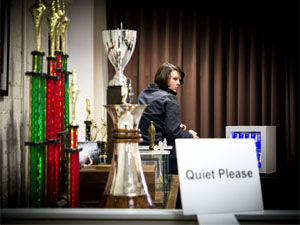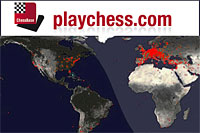
The 2015 U.S. Championship is an elite national championship event, featuring 12 of the strongest chess players in America. Over the course of eleven rounds, these competitors will battle for $175,000 in prize money, qualification into the World Championship cycle, and the coveted title of 2015 U.S. Champion.
U.S. Chess Championship - Round Seven
| Table |
White |
Rating |
Black |
Rating |
Result |
| 1 |
GM Akobian, Varuzhan |
2622 |
GM Troff, Kayden W |
2532 |
0-1 |
| 2 |
GM Kamsky, Gata |
2683 |
GM Holt, Conrad |
2530 |
1-0 |
| 3 |
GM So, Wesley |
2788 |
GM Onischuk, Alexander |
2665 |
1-0 |
| 4 |
GM Naroditsky, Daniel |
2633 |
GM Robson, Ray |
2656 |
0-1 |
| 5 |
GM Shankland, Samuel L |
2661 |
GM Gareev, Timur |
2604 |
1-0 |
| 6 |
GM Sevian, Samuel |
2531 |
GM Nakamura, Hikaru |
2798 |
½-½ |
Akobian, Varzuhan 0-1 Troff, Kayden
Akobian obtained a nice edge from this Grunfeld, and it seemed as if Troff would be tortured for some time. However, a big blunder from Akobian allowed a nice combination from Troff. After this Black had a very pleasant endgame that he was able to convert.

After winning his first round, Varzuhan Akobian seems to be completely out of shape
Kamsky, Gata 1-0 Holt, Conrad

[Event "U.S. Championship 2015"] [Site "Saint Louis"] [Date "2015.04.08"] [Round "7"] [White "Kamsky, Gata"] [Black "Holt, Conrad"] [Result "1-0"] [ECO "A06"] [WhiteElo "2683"] [BlackElo "2530"] [Annotator "Josh Friedel"] [PlyCount "109"] [EventDate "2015.??.??"] [EventCountry "USA"] [SourceDate "2015.02.07"] 1. Nf3 d5 2. g3 Nf6 3. Bg2 c6 4. d3 Bg4 5. Nbd2 e6 6. h3 Bh5 7. g4 $5 {A double-edged move.} (7. O-O Be7 8. e4 {is more typical for King's Indian Attack.}) 7... Bg6 8. Nh4 {White secures the two bishops, but is seriously lacking in space.} Be7 9. e3 Qc7 10. Qe2 Nfd7 {Black tries to force White to clarify the position with Nxg6.} 11. Ndf3 Ne5 $5 {Black wants to put the other knight on d7.} 12. Nxe5 Bxh4 {While I don't think you can call this move an error, it looks a little awkward to put the bishop here.} (12... Qxe5 13. Nxg6 hxg6 {looks simpler to me, leaving the bishop back on e7.}) 13. Nxg6 hxg6 14. Bd2 Nd7 15. O-O-O O-O-O 16. Kb1 {Despite the slightly unusual opening, this position is pretty standard. White has the bishops, but Black has an excellent structure that controls them well.} Rhe8 17. Rc1 Nc5 $6 {This move looks artificial to me.} (17... Kb8 {looks like a non-committal improving move, waiting to see White's plans.}) 18. f4 {A logical move, expanding and making Black think about g5.} (18. c4 {looks strong as well, with the idea that if} dxc4 19. d4 $1 {followed by taking on c4 and White has opened up lines for the g2 bishop.}) 18... e5 {Black has to try a central break, or else he'll simply end up worse.} (18... Be7 19. h4 Kb8 20. h5 {and White is taking over the kingside.}) 19. g5 f5 $6 {It is understandable to want to free the bishop, but this severely weakens his pawn structure.} (19... Ne6 20. Qg4 Rh8 {and while the bishop is awkward on h4, it can't be won. I'd definitely take White here, but it isn't easy to prove anything.}) 20. gxf6 Bxf6 21. fxe5 Qxe5 22. Qg4+ Ne6 {Black looks very active, but he has no real threats.} 23. c3 $1 {This move looks very passive, but it kills all of Black's play. The bishop on d2 is bad temporarily, but can come into the game later.} (23. d4 Qg5 {also looks promising for White, but now he has to worry about a knight landing on e4.}) 23... Qf5 24. Qxf5 gxf5 25. h4 {This ending is actually very dangerous for Black, despite the fact that Kamsky fixed Holt's structure a little bit. The f5 is still a weakness, and the two bishops are potentially very dangerous.} g6 $6 {This allows White to penetrate with his rook.} (25... Rh8 {was a more stubborn defense, but after} 26. h5 Rdf8 27. Rcf1 {Black is still under pressure.}) 26. h5 gxh5 27. Rxh5 {Despite the reduced material, Black will be hard pressed to defend here.} Ng7 28. Rh7 Rh8 29. Rch1 Rxh7 30. Rxh7 Kd7 31. Kc2 Ke7 {I think this is the wrong approach.} (31... Re8 32. Bh3 Kd6 {would be my defensive setup of choice, keeping the king closer to the queenside. Black is pretty immobilized, however, so White will have plenty of time to expand on the queenside and improve his pieces.}) 32. e4 $1 {Kamsky shows excellent understanding of the position. Despite the fact this leads to 3 vs 3, the bishops are extremely strong, and Black's king will have serious problems.} dxe4 33. dxe4 fxe4 34. Bxe4 Kf7 35. a4 {Gata is in no hurry.} Kg8 $6 {I understand that Black wanted to free his knight, but the king will simply be too far from his pawns.} (35... Re8 36. Bd3 Ke6) 36. Rh1 Ne6 37. Be3 a6 38. Bd3 Nc7 $6 {Conrad was scared of Bc4, but it was by far the lesser evil.} (38... Kf7 39. Bc4 b5 {is complicated, but Black seems to hold on.} 40. Rh7+ Kg8 41. Rh6 Kg7 $1 42. Bd3 {and while Black is still under pressure, he's not losing anything yet.} (42. Bxe6 $6 Re8 {wins the piece back and Black should survive.} )) 39. Bb6 (39. Rg1+ {was even more accurate, but the idea is similar.}) 39... Rd7 40. Bf5 Re7 41. Bc8 {Black's queenside looks very tender, and it isn't so easy to keep it defended.} Kg7 42. a5 $1 {Gata fixes the pawns on the light squares.} Nd5 43. Bc5 Rc7 (43... Re2+ 44. Kc1 Bg5+ 45. Kb1 {and Black's activity has run out.}) 44. Bf5 Be5 45. Kd3 {Black's pieces are running out of squares.} Nf6 46. Re1 (46. Ke3 $1 {and Black has no moves, though this is far from an obvious zugswang.}) 46... Nd7 47. Bf2 Bd6 48. Bd4+ Kf7 49. Kc4 Nf8 50. Bg4 {Black is unable to contend with threats against his king and the queenside.} Re7 (50... c5 {was likely necessary, but after} 51. Rf1+ Kg6 52. Bf5+ {the future looks grim.}) 51. Bh5+ Kg8 52. Rg1+ Kh7 53. Bg4 {Black's king is nearly mated. Bf5 is a powerful threat.} Kg6 54. Bc8+ Kh5 55. Rg7 {Black's king survives, but his queenside won't once the rooks are off. Gata recovers nicely from his loss yesterday with this win.} 1-0
So, Wesley 1-0 Onischuk, Alexander
A cool game: So was able to put a lot of pressure on Onischuk in a position that seemed relatively harmless at first. Black had regained his gambited pawn in the Marshall, but So proved that the piece placement was still dangerous for Black. Onischuk blundered a piece in a position where he was already under severe pressure.
Naroditsky, Daniel 0-1 Robson, Ray
Naroditsky's attempt in this Grunfeld was double-edged. His attack on the kingside was beat back, and Robson obtained a positional initiative with a monster bishop on d5. The Californian kept trying to invade and put pressure on his opponent's position, threatening checks and counter play, but Robson had it all under control. At one point, Robson was completely winning, but missed the excellent resource 54.g4! turning a completely won position into a draw.

Tied for first: Ray Robson
Naroditsky had the chance to give a perpetual and end the game, but he missed it and Robson was able to get some new winning chances. In horrible time pressure for both players Robson won the game, again, and this time finished it off.
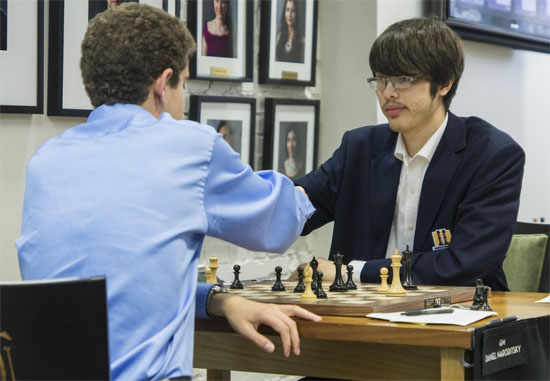
A marathon game, but Ray pulled it off in the end
Shankland, Sam 1-0 Gareev, Timur

[Event "U.S. Championship 2015"] [Site "Saint Louis"] [Date "2015.04.08"] [Round "7"] [White "Shankland, Samuel L"] [Black "Gareev, Timur"] [Result "1-0"] [ECO "C63"] [WhiteElo "2661"] [BlackElo "2604"] [Annotator "Josh Friedel"] [PlyCount "82"] [EventDate "2015.??.??"] [EventCountry "USA"] [SourceDate "2015.02.07"] 1. e4 e5 2. Nf3 Nc6 3. Bb5 f5 {One of Timur's more mainstream lines.} 4. d3 fxe4 5. dxe4 Nf6 6. O-O Bc5 7. Bxc6 (7. Qd3 {is the other main line these days, but Black has been doing okay here.}) 7... bxc6 8. Nxe5 O-O 9. Nc3 d6 10. Na4 { This has been played quite a few times recently. It looks fancy, but the idea is to ensure Black's dark-squared bishop gets captured..} (10. Nd3 {is the most common move, but after} Bd4 {Black gets to keep his bishop.}) (10. Nxc6 Qe8 {and Black will capture on e4 if the knight retreats.}) 10... Qe8 11. Nd3 Bg4 {This has been played twice by GM and Schliemann expert GM Roeland Pruijssers. He won both games against strong players, so we must assume he knows what he's doing.} 12. Qe1 Bd4 13. c3 Bb6 14. Nxb6 axb6 {All rather forced.} 15. c4 $5 {Shankland's novelty, though I'm not sure if it was prepared or over the board inspiration.} (15. f3 Be6 {was played in Bok-Pruijssers, and it looks quite unclear.}) 15... Be6 16. b3 {Sam's idea is to take control of the light squares, which wasn't possible in the 15. f3 line. } b5 $1 {Timur has to play actively, or else he's just be down a pawn.} 17. e5 {A principled try.} (17. cxb5 Bxb3 {is the idea, and after} 18. Qc3 Ba4 {with a messy position.}) 17... Bf5 $1 (17... bxc4 18. exf6 cxd3 19. fxg7 Rf5 $1 {is unclear, but Timur understandable didn't want his kingside to get decimated.}) 18. Nb4 $1 {Both sides are playing accurately.} (18. exf6 Bxd3 19. fxg7 Rf7 20. Qxe8+ Rxe8 21. Rd1 {and Black can choose between drawing with Bc2-Bd3 or playing for a win with bxc4. I think both continuations are close to equal.}) 18... dxe5 19. Qe3 {Logical, although maybe not best.} (19. cxb5 cxb5 20. Be3 { looks nice for White due to his better structure.}) 19... bxc4 20. bxc4 Qe6 21. Bb2 {Shankland correctly sacrifices a pawn.} Qxc4 $6 (21... Rab8 $1 {was a strong move, but the idea is far from obvious.} 22. a3 c5 $1 23. Qxc5 Nd7 {If White doesn't grab c7, c5 will be very strong.} 24. Qxc7 Rfc8 25. Qa5 {Black has sacked a couple pawns, but the queen is completely out of play now. There are many choices here, but I like} Be4 {with the idea of taking Ra8-Rc5 trapping the queen as well as Bxg2 with a perpetual.}) 22. a3 {Black is temporarily up a pawn, but he has a lot of weaknesses.} Ng4 23. Qc1 $1 { Clearly best, or else c5 was coming.} Qe2 (23... Qxc1 24. Raxc1 {and Black's pawn weaknesses ensure he will suffer here.}) 24. h3 Be4 $1 {Retreating the knight allows Re1 and Black's pawns all fall, so this was the move Timur counted on. Sam has a powerful response, however.} 25. Qe1 $1 (25. hxg4 $2 Bxg2 {and White is in trouble. The bishop is poisonous due to} 26. Kxg2 Qxg4+ 27. Kh1 Rf5 {and mate will be delivered shortly.}) 25... Qxb2 $6 (25... Qxe1 {was the better choice, but after} 26. Raxe1 Nf6 27. Bxe5 {White has a pleasant edge.}) 26. Qxe4 Nf6 27. Qc4+ Kh8 28. Nxc6 {The queens on help White, since Black's king is less safe than its counterpart on g1.} Rxa3 29. Rxa3 Qxa3 30. Nxe5 {This reminds me a lot of Kamsky's game from today. Despite the simplified material, Black will find holding this nearly impossible.} Qa5 31. Nf7+ Kg8 {There are no killer discoveries, but Shankland finds the most accurate way to play.} 32. Rd1 $1 {The knight can't be taken due to back rank mate, and Black doesn't have a lot of great options.} Qh5 (32... g6 {looks best, giving the king a little breathing room, but after} 33. Ng5+ Kh8 34. f4 $1 {followed by Kh2 and the attack will continue..}) 33. Ne5+ Kh8 34. Re1 {The queen is a bit stuck on h5.} Ng8 $6 (34... Qe8 {extricating the queen looks best.}) 35. Qxc7 Qf5 36. Qc5 Nh6 {This ends up being an unfortunate square for the knight, but it was hard to suggest a better move.} 37. g4 $1 Qf4 $2 (37... Qc8 {was necessary to continue the fight, but after} 38. Qd5 {White is still dominating.}) 38. Re4 $1 {Now Black is dead lost.} Qf6 (38... Qxe4 39. Qxf8+ Ng8 40. Nf7# {isn't helpful for Black.}) 39. Nd7 Qa1+ 40. Kh2 {The problem for black is that g5 is coming, and there is no adequate defense.} Ra8 41. g5 Qa7 { and Gareev resigned, not waiting for Shankland to play Qxa7 and gxh6. A very high calibre game despite the complexity of the position, and Sam played the latter part of the game almost flawlessly.} (41... Nf7 42. Qe7 {and Black can't defend against both Qxf7 and Qe8+.}) (41... Ng8 42. Ne5 {and Nf7 is a monster threat that can't be stopped. For instance, if} Qa2 (42... Qa7 43. Ra4 $1 {and neither piece can be taken due to Nf7.}) 43. Rf4 Ra7 {and White switches gears with} 44. Ng6+ $1 hxg6 45. Rh4+ Nh6 46. gxh6 {with mate coming soon.}) 1-0
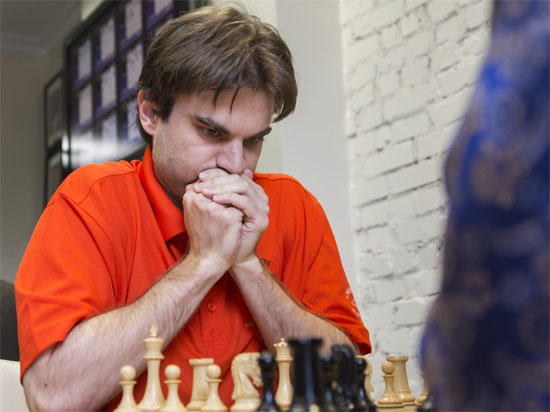
Sam Shankland played a fantastic game today
Sevian, Samuel ½-½ Nakamura, Hikaru
Nakamura got the better of Sevian in the opening, with his Berlin threat he forced Sevian into a passive Ruy Lopez. Sevian might have outplayed Nakamura slightly after that, and the players agreed to a draw in an equal position around move 40.

Sam Sevian draws number one seed Hikaru Nakamura
Pairings for Round Eight
| Table |
White |
Score |
Rating |
Black |
Score |
Rating |
| 1 |
GM Troff, Kayden W |
4.0 |
2532 |
GM Nakamura, Hikaru |
5.0 |
2798 |
| 2 |
GM Gareev, Timur |
2.0 |
2604 |
GM Sevian, Samuel |
4.0 |
2531 |
| 3 |
GM Robson, Ray |
5.0 |
2656 |
GM Shankland, Samuel L |
3.5 |
2661 |
| 4 |
GM Onischuk, Alexander |
3.5 |
2665 |
GM Naroditsky, Daniel |
1.5 |
2633 |
| 5 |
GM Holt, Conrad |
2.5 |
2530 |
GM So, Wesley |
4.5 |
2788 |
| 6 |
GM Akobian, Varuzhan |
2.5 |
2622 |
GM Kamsky, Gata |
4.0 |
2683 |
Standings

Replay Round Seven Games
Select from the dropdown menu to replay the games
U.S. Women's Championship - Round Seven
| Table |
White |
Rating |
Black |
Rating |
Result |
| 1 |
WGM Nemcova, Katerina |
2279 |
WCM Virkud, Apurva |
2132 |
1-0 |
| 2 |
WGM Foisor, Sabina |
2235 |
WFM Yu, Jennifer R |
2180 |
½-½ |
| 3 |
WIM Ni, Viktorija |
2188 |
WGM Abrahamyan, Tatev |
2322 |
½-½ |
| 4 |
IM Paikidze, Nazi |
2333 |
FM Melekhina, Alisa |
2235 |
1-0 |
| 5 |
GM Krush, Irina |
2477 |
WIM Wang, Annie |
1901 |
1-0 |
| 6 |
IM Goletiani, Rusudan |
2311 |
WGM Sharevich, Anna |
2267 |
0-1 |
Nemcova, Katerina 1-0 Virkud, Apurva
Nemcova absolutely destroyed Virkud positionally. The finish with the exchange sacrifice and the total domination of Black's pieces was very fitting.
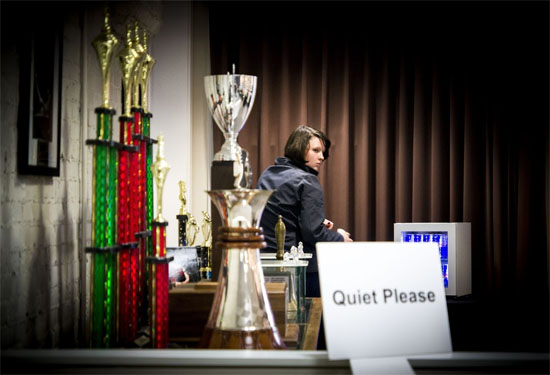
Katerina running away with the trophies?
Foisor, Sabina ½-½ Yu, Jennifer
Foisor blundered a pawn against Yu, who proceeded to outplay her opponent. With an extra two pawns, it seemed as if the game would surely be over, but somehow Yu failed to convert a very basic endgame. Actually, she did not even really try to make any progress...
Ni, Viktorija ½-½ Abrahamyan, Tatev
A bold Grand Prix attack from two players that were making their way up the rankings in the tournament after a slow start. Abrahamyan had scored the last 3.5/4 and Ni won her last two games. A sharp pawn sacrifice was followed by an exchange sacrifice that forced a perpetual.

Viktorija Ni was slightly lucky Tatev Abrahamyan allowed a perpetual
Paikidze, Nazi 1-0 Melekhina, Alisa

[Event "U.S. Womens Championship 2015"] [Site "Saint Louis"] [Date "2015.04.08"] [Round "7"] [White "Paikidze, Nazi"] [Black "Melekhina, Alisa"] [Result "1-0"] [ECO "A37"] [WhiteElo "2333"] [BlackElo "2235"] [Annotator "Josh Friedel"] [PlyCount "91"] [EventDate "2015.??.??"] [EventCountry "USA"] [SourceDate "2015.02.07"] 1. Nf3 g6 2. g3 c5 3. Bg2 Bg7 4. c4 Nc6 {We've transposed into a Symmetrical English.} 5. Nc3 d6 {This move order is very clever.} 6. O-O e5 7. d3 (7. Ne1 { is a typical idea, but here it is inaccurate due to} Be6 $1 8. d3 Nge7 {and Black is ready to play d5 before White's knight lands on e3.}) 7... Nge7 8. a3 O-O 9. Rb1 a5 {This move is a little weakening, but allowing b4 without a fight is usually just a pleasant edge for White.} 10. Bd2 Rb8 11. Ne1 Be6 12. Nc2 d5 {Black achieves the desired break, but the inclusion of a3-a5 gives White some weaknesses to work with.} 13. cxd5 Nxd5 14. Ne4 (14. Nxd5 Bxd5 15. Bxd5 Qxd5 16. b4 {is an alternative, but it looks pretty comfortable for Black. } cxb4 17. axb4 b6 $13) 14... b6 15. Ng5 {White has to play for concrete threats, or else she'll simply be on the wrong side of a bad maroczy bind.} Bc8 16. Ne3 Nxe3 {Ideally Black would like to keep pieces on the board, but in this case I think Alisa made the right decision.} (16... Nde7 17. Nc4 {and I'm not sure how Black should consolidate.}) 17. Bxe3 Nd4 {Black has to be happy with how she's emerged from the opening.} 18. b4 $6 {A normal idea, but it shouldn't work very well here.} (18. Re1 {is a sad move, but it prepares b4 and waits waits for Black to commit the light-squared bishop.}) 18... cxb4 19. axb4 Bg4 (19... a4 {was simple and strong. The pawn is immune to capture, and if Black gets in b5 she'll be slightly better.}) 20. f3 $6 {This ugly move shouldn't be necessary.} (20. Re1 {Once again, I'd prefer this timid move over the text.}) 20... Bd7 21. Ne4 axb4 $2 {This is completely the wrong approach. Black almost never wants to simplify on the queenside in these lines.} (21... a4 {and Black is just much better.}) 22. Bxd4 exd4 23. Qb3 {Now the game is far less clear.} Re8 24. f4 Bf8 25. Ng5 Be6 $2 {This looks completely unnecessary.} (25... Qf6 26. Bd5 {and Black can play} Rxe2 27. Bxf7+ Kh8 {and I'd still take Black.}) 26. Nxe6 fxe6 {White's position is now more solid than Black's, despite the temporary pawn deficit.} 27. f5 {in the right spirit of the position. White should be playing against Black's king.} gxf5 28. Rxf5 Rc8 29. Bd5 $5 {A spectacular looking move, but not one which really changes the evaluation much.} (29. Rf4 {followed by doubling on the f-file looks simpler.}) 29... Qd6 30. Rg5+ Kh8 31. Be4 Rc5 {Alisa has defended well, and the White rook is a little out of place now.} 32. Rg4 b5 $6 {I'm not sure what this move does.} (32... Rec8 {looks more useful, with the idea that b4 can't be captured due to Rc1+.}) 33. Rf1 Rc3 34. Rf7 $1 {Nazi chooses to ignore the attack on her queen.} Rc7 35. Rf5 $1 {and prepares Rh5. Her rook is immune again, this time due to mate on g8.} Bh6 $6 (35... Rc5 {was better, preventing White from achieving her aim.}) 36. Rxb5 Be3+ 37. Kg2 {The bishop on e3 looks nice, but that's about all it does. White's snapped a pawn for free, and is ready to continue her attack.} Qf8 38. Bf3 Rc1 {This doesn't really threaten anything, but it's hard to recommend a better move.} 39. Qxb4 Rg1+ $6 {The king on h3 will be perfectly safe, while the rook on g1 is merely a tourist.} (39... Qxb4 40. Rxb4 Rc7 {is Black's best shot, but this ending will be pure suffering.}) 40. Kh3 Qf7 {This loses right away, but it was lost anyway.} 41. Qd6 Qf6 42. Rb8 {Black has no defense to the numerous threats.} Qh6+ 43. Rh4 Qg6 44. Rxe8+ Qxe8 45. Qe5+ Kg8 46. Rg4+ {Black resigns before White can deliver mate. Alisa won the opening battle, but after a couple of errors Nazi took over the initiative and never let it go.} 1-0
Krush, Irina 1-0 Wang,Annie
Krush destroyed Wang in a positional struggle, and normally that would be sufficient to wrap up the game's summary. However it is almost incomprehensible how a full-fledged grandmaster like Irina Krush, top seed and defending U.S. Women's Champion, was able to miss the simplest combination on move twelve that would simply have won a piece. You can take a look at the game and surely you will find it without any problem.

The moves after this were 9...Qxf6 10. dxc3 Bc5 11. Bxe6 fxe6?? 12.Nf3?? Can you find the missed win?
Goletiani, Rusudan 0-1 Sharevich, Anna

[Event "U.S. Womens Championship 2015"] [Site "Saint Louis"] [Date "2015.04.08"] [Round "7"] [White "Goletiani, Rusudan"] [Black "Sharevich, Anna"] [Result "0-1"] [ECO "A06"] [WhiteElo "2311"] [BlackElo "2267"] [Annotator "Josh Friedel"] [PlyCount "86"] [EventDate "2015.??.??"] [EventCountry "USA"] [SourceDate "2015.02.07"] 1. Nf3 d5 2. g3 Nf6 3. Bg2 c6 4. b3 {It is slightly unusual to commit to the fiancetto so early, but it isn't unheard of by any means.} Bg4 5. Bb2 Nbd7 6. O-O Qc7 {This move has a strange feel to it, as I'm not sure the queen wants to be here in many lines.} (6... e6 {is standard.}) 7. d4 (7. c4 {would be my choice, with the idea of playing Nc3-Rc1 later and making the queen feel unwelcome on c7.}) 7... e6 8. c4 Be7 9. Nc3 O-O 10. h3 (10. Rc1 {still looks good to me, although it does a lot less with the pawn on d4, since White won't have d3-e4 ideas later.}) 10... Bf5 11. Nd2 (11. Nh4 {would be desireable, but} Be4 12. Nxe4 (12. f3 {is possible with the pawn back on h2, but not here.}) 12... dxe4 {and the knight is very awkward on h4.} (12... Nxe4 13. Nf3 f5 {is also perfectly fine for Black.})) 11... Rad8 12. Rc1 Qb8 13. e3 (13. e4 Nxe4 14. Ncxe4 dxe4 15. Nxe4 Nf6 {and Black has nothing to fear. All trades are helpful, and Black can slowly gang up on the d4 pawn.}) 13... b5 (13... h6 { followed by Bh7 gives White even less to work with, but what Anna played is standard and can't be wrong.}) 14. cxb5 cxb5 15. Qe2 a6 16. a3 (16. e4 {should be on White's radar now, since it opens lines for White's pieces. Note how the g2 bishop is a lot better when it doesn't run into b7-c6.} dxe4 17. Ncxe4 Nd5 { and White can choose between ideas of Nf3-e5 and a3-b4 followed by Nc5. The position is roughly equal.}) 16... h6 17. g4 $2 {This is just completely the wrong approach. White's pieces just aren't prepared for attacking, and the open c-file will give Black plenty of counterplay.} (17. e4 {Now I would certainly play this move, as b4-Nc5 can be played even faster.}) 17... Bh7 18. f4 Rc8 19. Bf3 (19. g5 {looks like a logical follow up, but after} hxg5 20. fxg5 Ne8 21. h4 Nd6 {It is clear White's king is in worse shape than Black's.}) 19... Ne8 20. Kg2 (20. e4 {This looks loose, but I'd try to play this move while I had the chance.} dxe4 21. Bxe4 Bxe4 22. Ndxe4 {and while I'd still take Black, White has some counterplay coming with Qf3-f5.}) 20... Nd6 21. Rh1 $6 Bh4 $1 {I like this move a lot, as it keeps White from trying anything on the h-file.} 22. Rhg1 a5 23. Kh1 Rc7 24. Qh2 b4 25. axb4 axb4 26. Na4 Rfc8 { Sharevich is playing excellent chess. White is in huge trouble.} 27. Rxc7 Rxc7 28. f5 {Rusa's only try.} Rc2 29. Bd1 (29. Rc1 {would probably have been my move, but after} Rxc1+ 30. Bxc1 exf5 31. Bxd5 fxg4 32. hxg4 Be7 {White's king is simply too exposed.}) 29... Rc8 $2 {Anna misses her chance.} (29... Rxd2 $1 30. Qxd2 Ne4 {and White is just toast. After the forced} 31. Qh2 Ng3+ 32. Rxg3 (32. Kg2 exf5 {is hopeless.}) 32... Bxg3 {and Black will take on f5 with an overwhelming position.}) 30. Nc5 $1 {Rusa spots her chance, and the game has become unclear.} Nxc5 31. dxc5 Rxc5 32. fxe6 fxe6 (32... Qf8 {might be safer, but it is clear something has gone wrong for Black.}) 33. Qe5 {Now Black is the one who has to be careful.} Rc3 $1 {Sharevich finds the best defensive move. The b2 bishop has to be blocked at all costs.} 34. Rf1 Bf6 (34... Kh8 { I'd get the king out of the check ASAP.}) 35. Qxe6+ Nf7 36. Bf3 {Bxd5 is a major threat.} Rc2 $2 {I'd imagine there was severe time pressure here, and both players made some severe errors.} (36... Kh8 {Once again, I want to extricate my king, but here I rely on a tactic.} 37. Qxf7 Rc7 38. Qxd5 Bxb2 { and despite being down a pawn, Black's king is safe and the two bishops should promise enough counterplay.}) 37. Bxd5 $4 {A huge blunder.} (37. Bxf6 {is winning pretty simply.} Bg6 (37... gxf6 38. Bxd5 {is over.}) (37... Rxd2 38. Be5 $1 {is a key resource, and maybe what Rusa missed. The idea is that after} Qxe5 39. Qc8+ {leads to mate.}) 38. Bxg7 $1 Kxg7 39. Bxd5 Rxd2 40. Rxf7+ Bxf7 41. Qxf7+ Kh8 42. Qf6+ Kh7 43. Be4+ Kg8 44. Qg6+ Kf8 45. Qxh6+ {and White has way too many pawns.}) 37... Bg6 $4 {Anna returns the favor.} (37... Rxd2 38. Qxf7+ Kh8 {and mate on h2 can't be stopped without huge material losses. One key point is that after} 39. Be5 Bxe5 40. Qf8+ {Black has} Bg8 {and Black remains up a piece.}) 38. Bxf6 {Now Rusa is won again.} Rxd2 39. Be5 Qd8 40. e4 $4 {As has happened to so many players, the last blunder comes on move 40.} ( 40. Rxf7 {leads to a won rook ending.} Qxd5+ 41. Qxd5 Rxd5 42. Rxg7+ Kf8 43. Rxg6 Rxe5 44. Rf6+ Kg7 45. Rf3 {and two pawns should be enough to win.}) 40... Qh4 {Now mate is inevitable.} 41. g5 Bxe4+ 42. Kg1 Qxg5+ 43. Qg4 Rg2+ {Quite an exciting game. Sharevich held a large advantage for most of it, but towards the end the point was really up for grabs. A much needed win for Anna, and a rough loss for Rusa, who's chances of playing for first are severely compromised.} 0-1
Pairings for Round Eight
| Table |
White |
Rating |
Black |
Rating |
| 1 |
WCM Virkud, Apurva |
2132 |
WGM Sharevich, Anna |
2267 |
| 2 |
WIM Wang, Annie |
1901 |
IM Goletiani, Rusudan |
2311 |
| 3 |
FM Melekhina, Alisa |
2235 |
GM Krush, Irina |
2477 |
| 4 |
WGM Abrahamyan, Tatev |
2322 |
IM Paikidze, Nazi |
2333 |
| 5 |
WFM Yu, Jennifer R |
2180 |
WIM Ni, Viktorija |
2188 |
| 6 |
WGM Nemcova, Katerina |
2279 |
WGM Foisor, Sabina |
2235 |
Standings
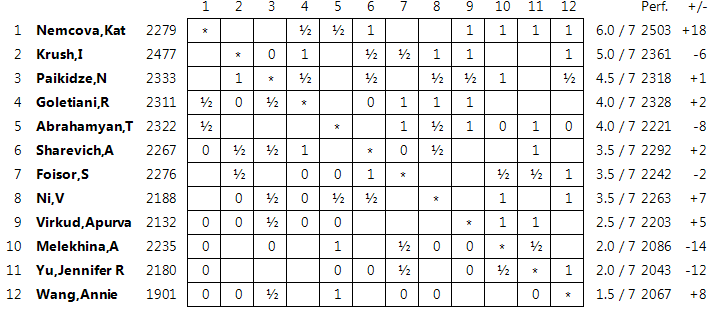
Replay Round Seven Games
Select from the dropdown menu to replay the games
Commentary provided for the Chess Club and Scholastic Center of Saint Louis by Josh Friedel:
Joshua Friedel
Josh was born in 1986 in New Hampshire, USA and is currently living in Wisconsin. He obtained his international master title in 2005 and his grandmaster in 2008. He has participated in six US Championships, including a tie for fourth in 2008. Major Open tournament victories include: the 2003 Eastern Open, 2005 Berkeley Masters, 2008 National Open, 2009 Edmonton International, 2009 North American Open, 2010 Saint Louis Open, 2010 American Open, 2013 Chicago Open.
Josh will be annotating the games for the Saint Louis Chess Club. |
 |
Photos by Lennart Ootes
